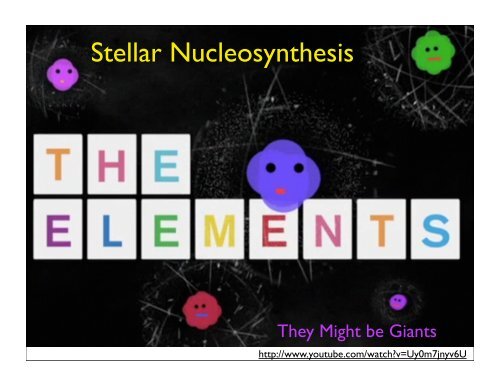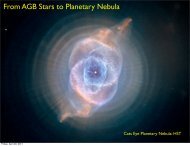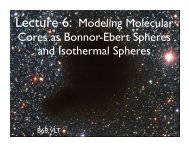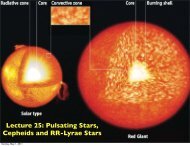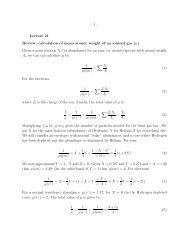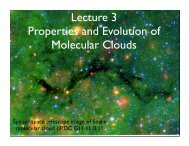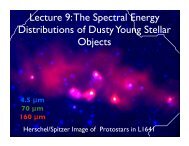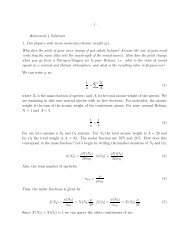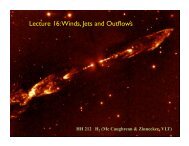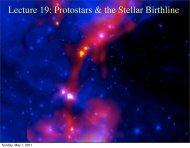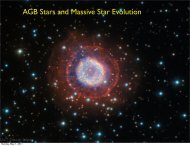Stellar Nucleosynthesis
Stellar Nucleosynthesis
Stellar Nucleosynthesis
You also want an ePaper? Increase the reach of your titles
YUMPU automatically turns print PDFs into web optimized ePapers that Google loves.
<strong>Stellar</strong> <strong>Nucleosynthesis</strong>They Might be Giantshttp://www.youtube.com/watch?v=Uy0m7jnyv6U
Elemental Abundances in the Solar SystemSynthesized in the Big BangWe need to consider the creation of all the other elementsin stars.
Abundances of nuclei3Slide: Stephen Smartt
Review: Nuclear Fusion in Stars
Review: Binding Energy of Nuclei
Review: Mass ExcessAtomic Number (Z)Atomic Weighthttp://ie.lbl.gov/systematics/chart_qme.pdf
Rate of Reactions
The Coloumb BarrierFor 12 C and α1 fm = 10 -15 mhttp://nu.phys.laurentian.ca/~fleurot/fusionrate/
Occurrence of fusion reactionsNow will discuss the conditions under which fusion can occur – and whether suchconditions exist in stellar interiors• Nuclei interact through four forces of physics – only electromagnetic and strong nuclearimportant here• Two positively charged nuclei must overcome coulomb barrier (long range force ∝1/r 2 ), toreach separation distances where strong force dominates (10 -15 m, typical size ofnucleus)Schematic plots• V (potential energy) vs nuclei separation distance• Wave function representing penetration of a potentialbarrier by nucleus with kinetic energy of approach E kin(below barrier height).Slide: Stephen Smartt9
Quantum TunnelingAs derived in your Quantum Mechanics courses, there is a finite probability for aparticle to penetrate the Coulomb barrier as if “tunnel” existed.Quantum effect discovered by George Gamow (1928) in connection with radioactivity.Penetration probability (calculated by Gamow) is given as:−πZ 1 Z 2 e 2εe 0 hvHence this increases with v (particle velocity), but we know v will be Maxwelliandistribution for ideal gas. Hence fusion probability is product−πZ 1 Z 2 e 2εprob( fusion) ∝e 0 hve − mv 22kT10Slide: Stephen Smartt
The Gamow peakSchematically this is plotted, and the fusionmost likely occurs in the energy windowdefined as the Gamow Peak.The Gamow peak is the product of theMaxwellian distribution and tunnellingprobability. The area under the Gamow peakdetermines the reaction rate.The higher the electric charges of the interacting nuclei, the greater therepulsive force, hence the higher the E kin and T before reactions occur.Highly charged nuclei are obviously the more massive, so reactions betweenlight elements occur at lower T than reactions between heavy elements.11Slide: Stephen Smartt
The Gamow Peak
ResonancesResonanceC 12 + P => N 13 + γCalculation ofGamow peak assumesthat the process is farfrom a resonances.Resonances canincrease the crosssection of a reactionsignificantly andconsequently increasethe reaction rate.From Clayton: Principles of <strong>Stellar</strong>Evolution and <strong>Nucleosynthesis</strong>
Hydrogen and helium burningThe most important series of fusion reactions are those converting H to He (H-burning).As we shall see this dominates ~90% of lifetime of nearly all stars.• Fusion of 4 protons to give one 4 He is completely negligible• Reaction proceeds through steps – involving close encounter of 2 particles• We will consider the main ones: the PP-chain and the CNO cycleThe PP ChainThe PP chain has three main branches called the PPI, PPII and PPIII chains.PPI Chain1 p + p → d + e + + ν ePPII Chain3' 3 He + 4 He → 7 Be + γPPIII Chain4'' 7 Be + p → 8 B + γ2 d + p → 3 He + γ4' 7 Be + e − → 7 Li + ν e5'' 8 B → 8 Be + e + + ν e3 3 He + 3 He → 4 He + 2p5' 7 Li + p → 4 He + 4 He6'' 8 Be → 2 4 He14Slide: Stephen Smartt
Relative importance of PPIand PPII chains (branchingratios) depend on conditionsof H-burning (T,ρ ,abundances). The transitionfrom PPI to PPII occurs attemperatures in excess of1.3×10 7 K.Above 3×10 7 K the PPIIIchain dominates over theother two, but anotherprocess takes over in thiscase.15Slide: Stephen Smartt
The Three P-P ChainsFrom Clayton: Principles of <strong>Stellar</strong>Evolution and <strong>Nucleosynthesis</strong>
When does a given P-P chain dominate?FPPIFPPIIFPPIIIFrom Clayton: Principles of <strong>Stellar</strong>Evolution and <strong>Nucleosynthesis</strong>
Energy production and neutrino emissionEnergy released in the formation of an α particle by fusion of four protons. Is essentiallygiven by the difference of the mass excesses of four protons and one α particle.Q p− p= [ 4ΔM( 1 H) − ΔM( 4 He) ]c 2 = 26.7 MeVSince any reaction branch that completes this must turn 2 protons in 2 neutrons, twoneutrinos are also emitted, which carry energy away from the reaction site.It is these neutrinos that directly confirm the occurrence of nuclear reactions in theinterior of the Sun. No other direct observational test of nuclear reactions is possible.The mean neutrino energy flux is ~0.26MeV for d creation (PPI/II) and ~7.2MeV for Bdecay (PPIII). But as PPIII is negligible, the energy released for each He nucleusassembled is ~26MeV (or 6 ×10 14 JKg -1 )18Slide: Stephen Smartt
The CNO CycleAt birth stars contain a small (2%) mix of heavy elements, some of the most abundantof which are carbon, oxygen and nitrogen (CNO). These nuclei may induce a chain ofH-burning reactions in which they act as catalysts.The process is known as the CNO Cycle. There are alternative names that you maycome across :• The CNO bi-cycle• The CNOF cycle• The CN and NO cycles• The CN and NO bi-cyclesIn this course we will just refer to it all as the CNO cycle – and discuss the branches,but not specifically label them.19Slide: Stephen Smartt
The main branch1 12 C + p → 13 N + γ2 13 N → 13 C + e + + ν e3 13 C + p → 14 N + γ4 14 N + p → 15 O + γ5 15 O → 15 N + e + + ν e6 15 N + p → 12 C + 4 HeIn the steady state case, the abundancesof isotopes must take values such that theisotopes which react more slowly havehigher abundance. The slowest reaction isp capture by 14 N . Hence most of 12 C isconverted to 14 N.20Slide: Stephen Smartt
Temperature dependence of PP chain andCNO CycleThe two processes have very different temperature dependences. The rate of energyproduction in each:ε PP= ε 0ρX H2⎛⎛⎜⎜⎝⎝TT 0⎞⎞⎟⎟⎠⎠4.6⎛⎛ T ⎞⎞ε CNO= ε 0ρX HX CNOf N ⎜⎜ ⎟⎟⎝⎝ 25 ×10 6 ⎠⎠16.7€Equating this two gives the T at which they produce the same rate of energyproduction:€ ⎛⎛ XT ≈1.7 ×10 7 H⎞⎞⎜⎜ ⎟⎟⎝⎝ 50X CN ⎠⎠112.1KBelow this temperature the PP chain is most important, and above it the CNO Cycledominates. This occurs in stars slightly more massive than the sun e.g. 1.2-1.5M .€21Slide: Stephen Smartt
22Slide: Stephen Smartt
Changes in Elemental Abundances During CNOCaughlan 1962
Changes in Elemental Abundances During CNOCaughlan & Fowler 1962
Helium Burning: the triple-α reaction.Simplest reaction in a helium gas should be the fusion of two helium nuclei. There is nostable configuration with A=8. For example the beryllium isotope 8 Be has a lifetime ofonly 2.6×10 -16 s4He + 4 He → 8 BeBut a third helium nucleus can be added to 8 Be before decay, forming 12 C by the “triplealpha”reaction4He + 4 He → 8 Be8Be + 4 He → 12 C + γ25Slide: Stephen Smartt
Helium Burning: the triple-α reaction.Fred Hoyle (1952-54) suggested this small probability of α-capture by short lived8Be would be greatly enhanced if the C nucleus had an energy level close to thecombined energies of the reacting 8 Be and 4 He nuclei. The reaction would be afaster “resonant” reaction.This resonant energy level of 12 C was not experimentally known at the time. Hoyle’sprediction led to nuclear experiment at Caltech, and resonant level discovered.Thus helium burning proceeds in a 2-stage reaction, and energy released isQ 3α= [ 3ΔM( 4 He) − ΔM( 12 C) ]c 2 = 7.275MeVIn terms of energy generated per unit mass ≡ 5.8 ×10 13 JKg -1 (I.e. 1/10 ofenergy generated by H-burning). But the T dependence is astounding:ε 3α∝ ρ 2 T 4026Slide: Stephen Smartt
Carbon and oxygen burningCarbon burning (fusion of 2 C nuclei) requires temperatures above 5 ×10 8 K, and oxygenburning in excess of 10 9 K.Interactions of C and O nuclei are negligible – as at the intermediate temperatures required bythe coulomb barrier the C nuclei are quickly destroyed by interacting with themselves12C + 12 C → 24 Mg + γ→ 23 Mg + n→ 23 Na + p→ 20 Ne + α→ 16 O + 2α16O + 16 O → 32 S + γ→ 31 S + n→ 31 P + p→ 28 Si + α→ 24 Mg + 2αThe branching ratios for these reactions are temperature dependent probabilities.12C + 12 C → ~13MeV (~5.2 ×10 13 JKg -1 )16O + 16 O → ~16MeV (~4.8 ×10 13 JKg -1 )These reactions produce p, n, α, which are immediately captured by heavy nuclei, thusmany isotopes created by secondary reactions.27Slide: Stephen Smartt
Silicon burning: nuclear statistical equilibriumTwo Si nuclei could fuse to create 56 Fe – the end of the fusion chain.But now very high Coulomb barrier, at T above O burning, but below that requiredfor Si burning, photodisintegration takes place16O + α ↔ 20 Ne + γThis produces Ne at T~10 9 K but reverses above 1.5 ×10 9 K.Si disintegration occurs around 3×10 9 K, and the light particles emitted arerecaptured by other Si nuclei.Although the reactions tend to a state of equilibrium, a leakage occurs towardsthe stable iron group nuclei (Fe, Co, Ni), which resist photodisintegration up to7×10 9 K.28Slide: Stephen Smartt
Major nuclear burning processesCommon feature is release of energy by consumption of nuclear fuel. Rates ofenergy release vary enormously. Nuclear processes can also absorb energy fromradiation field, we shall see consequences can by catastrophic.NuclearFuelProcessT threshold10 6 KProductsEnergy per nucleon (Mev)H PP ~4 He 6.55H CNO 15 He 6.25He 3α 100 C,O 0.61C C+C 600 O,Ne,Ma,Mg 0.54O O+O 1000 Mg,S,P,Si ~0.3Si Nuc eq. 3000 Co,Fe,Ni
The s-process and r-processInteraction between nuclei and free neutrons (neutron capture) – the neutrons areproduced during C, O and Si burning.Neutrons capture by heavy nuclei is not limited by the Coulomb barrier – so couldproceed at relatively low temperatures. The obstacle is the scarcity of free neutrons.If enough neutrons available, chain of reactions possible:I(A, Z) + n → I 1 (A+1, Z)I 1 (A+1, Z) + n → I 2 (A+2, Z)I 2 (A+2, Z) + n → I 3 (A+3, Z) …etcIf a radioactive isotope is formed it will undergo β-decay, creating new element.I N (A+N, Z) → J(A+N, Z+1) + e − +If new element stable, it will resume neutron capture, otherwise my undergo seriesof β-decaysJ(A+N, Z+1) → K(A+N,Z+2) ν + e − +K(A+N, Z+2) → L(A+N, ν Z+3) + e − +30Slide: Stephen Smartt
In the process two types of reactions and two types of nuclei are involved:Neutron captures and β-decays ; stable and unstable nucleiStable nuclei may undergo only neutron captures, unstable ones my undergo both, withthe outcome depending on the timescales for the two processes.What can we say about the timescales of these processes ?Hence neutron capture reactions may proceed more slowly or more rapidly thanthe competing β-decays. The different chains of reactions and products are calledthe s-process and r-process.31Slide: Stephen Smartt
Some basic examples⇒Simple explanation of r and s process on:ultraman.ssl.berkeley.edu/nucleosynthesis.html32Slide: Stephen Smartt
1.We described the basic accounting for nuclear reactions. This accounting includes:1.1.the mass excess (binding energy released when creating an element)1.2.the rate of interactions (depends on the density, mass fractions, and rate coefficient).1.4.This hides most of the physics.Summary2.Iron has highest binding energy3. In the Sun, the P-P chain dominates4.There are three P-P chains, the other two require He 35. At higher temperatures (> 10 6 K), the CNO cycle takes over (using existing C, N and Oabundances in star). This rearranges the C, N, and O temperatures.6. At 100 K, Carbon burning occurs.7. Triple α requires unstable Be 8 as an intermediary state.8.Silicon Burning (at 10 9 K) will be described in next lecture9.We introduced the S and R processes. These work by Neutron capture: S-process (slowprocess) occurs when Β decay faster than neutron capture, the R-process (rapid process)when neutron capture is much faster than Β decay.


